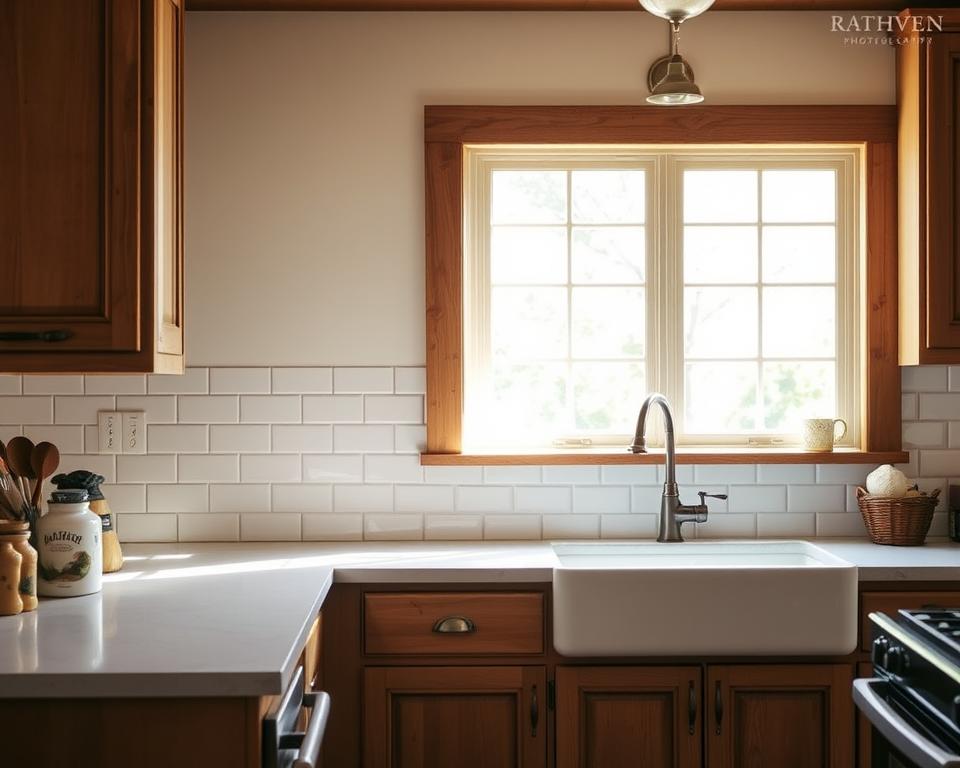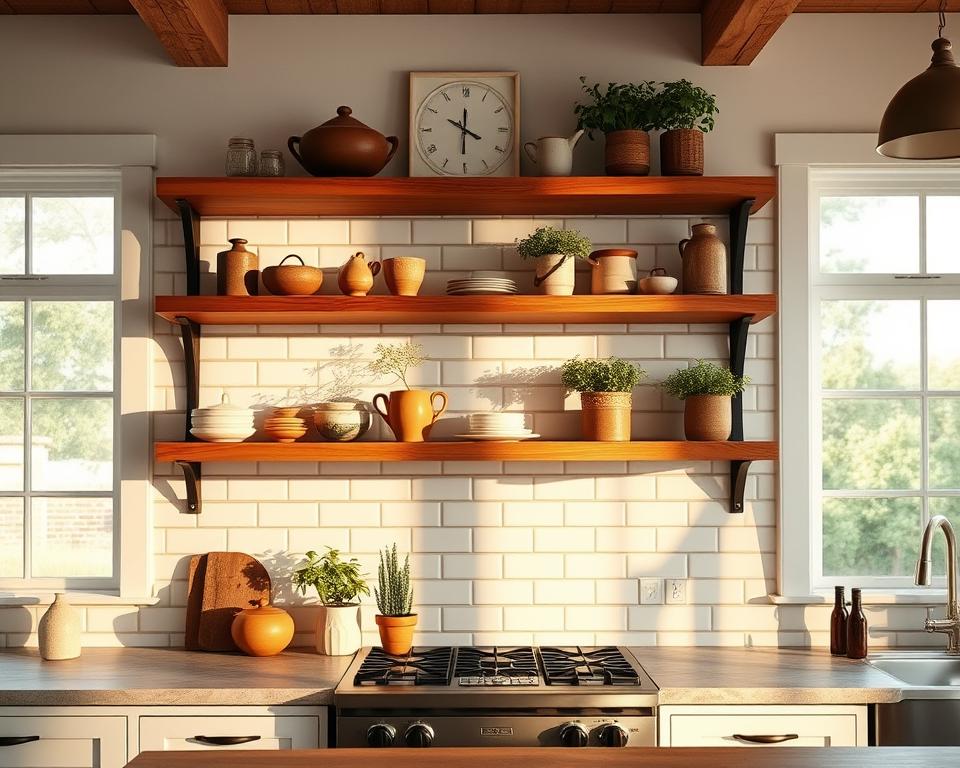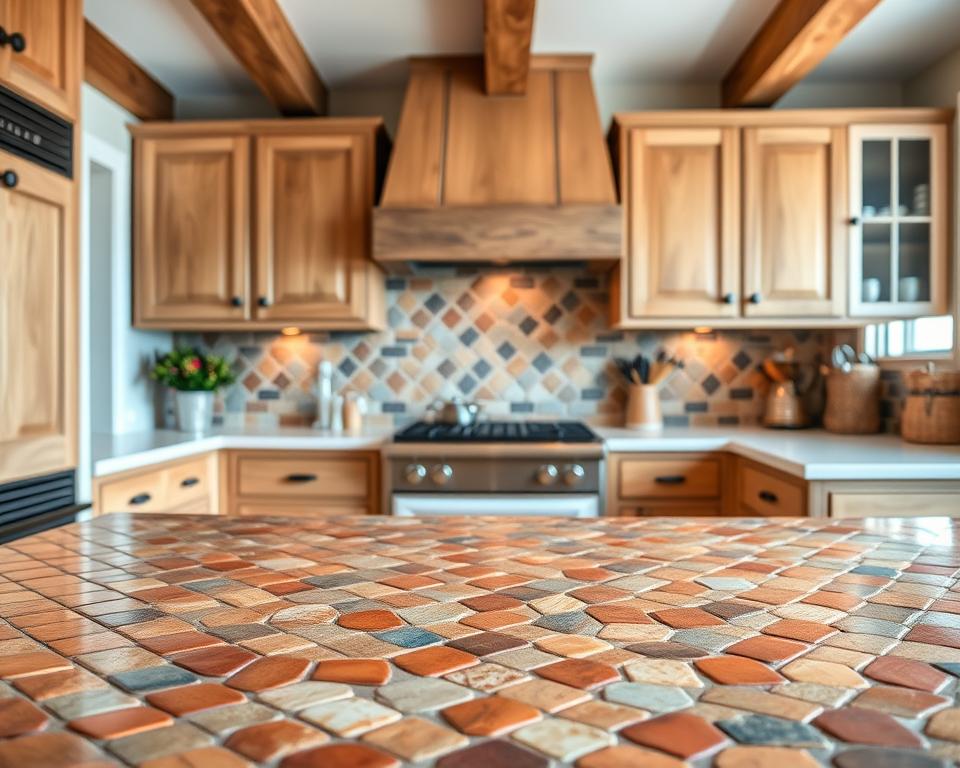Looking to refresh your kitchen? A farmhouse backsplash can transform a simple wall into a stunning centerpiece. With 39 unique designs, from white Shaker cabinets with vertical shiplap to patterned tiles in soft green, these options blend rustic appeal with contemporary functionality. Whether you’re drawn to the handmade beauty of Moroccan Zellige tiles or the practicality of a slab quartz backsplash, the right choice enhances your kitchen’s style while safeguarding your walls. Consider combining materials like limestone or beadboard to merge timeless warmth with modern trends.
Key Takeaways
- 39 farmhouse backsplash styles mix materials like tile, wood, and stone for modern or rustic looks.
- White Shaker cabinetry with vertical shiplap creates low-contrast elegance in modern farmhouse kitchens.
- Zellige tiles and salvaged brick add texture, while slab quartz offers low-maintenance durability.
- Monochrome schemes—matching cabinets to backsplashes—unify spaces, like sage green cabinets with coordinating tiles.
- Hand-painted or checkerboard tiles let you infuse personal flair without sacrificing function.
Embracing the Farmhouse Aesthetic
Farmhouse style beautifully merges rustic charm with modern functionality. It transforms kitchens into warm, inviting spaces where every element has a story. Let’s dive into how this timeless look influences backsplash choices and boosts your kitchen’s ambiance.
Understanding the Farmhouse Style
Farmhouse design is deeply rooted in rural simplicity. It eschews excessive ornamentation, instead embracing natural materials like wood and stone. Neutral color schemes are also key, with over 50% of farmhouse kitchens opting for light tones. This palette, often featuring pale blues and creamy neutrals, sets the stage for backsplash ideas that emphasize texture and authenticity.
Key Features of Farmhouse Design
Wood beams, open shelving, and vintage accents are hallmarks of farmhouse charm. Backsplash designs are crucial in integrating these elements. Popular options include:
- Neutral tile or painted options for timeless appeal
- Wooden or stone materials to echo nature’s textures
- Open shelving (35% of kitchens use this) paired with simple backsplash ideas
Antique touches, such as apron sinks and stained wood tones, add depth. About 45% of farmhouse kitchens choose backsplashes that blend functionality with rustic beauty. Whether you’re renovating or updating, these elements make your kitchen feel both lived-in and stylish.
Popular Materials for Backsplashes
When selecting a material for your farmhouse kitchen backsplash, it’s crucial to find a balance between aesthetics and functionality. Popular choices include ceramic, stone, and wood, each with its own set of advantages. Understanding these benefits will help you make an informed decision.
Tile vs. Stone: Which is Better?
Backsplash tiles, such as ceramic or porcelain, are favored for their durability. They are resistant to stains and heat, making them perfect for everyday use. The cost of installation varies from $12 to $32 per square foot, influenced by the complexity of the design. For instance, glass backsplash tiles can make small spaces appear larger by reflecting light, but they may require more frequent cleaning than ceramic.
- Ceramic/porcelain: Affordable, non-porous, and easy to clean
- Natural stone (marble, granite): Adds elegance but requires resealing every 1–3 years
- Metal tiles: Stainless steel options cost $25–$75/sq ft but offer quick DIY backsplash installation without grout
The Rise of Shiplap in Kitchen Design
“Shiplap’s rustic texture brings instant warmth to farmhouse kitchens,” says interior designer Emily Carter.
Shiplap, whether used horizontally or vertically, introduces a cozy atmosphere to kitchens. Its installation involves nailing planks to the wall, with costs ranging from $18 to $26 per square foot. Choosing pre-primed options can save time. Painting shiplap white or using muted tones like “cloud” or “driftwood” ensures a timeless look. A pro tip is to combine shiplap with open shelving for an airy feel.
Color Schemes for a Cozy Look
Choosing the right color for your backsplash sets the tone for your entire kitchen. Backsplash trends in 2024 lean toward harmonizing timeless neutrals with bold accents. Let’s explore how to balance classic and daring choices.
35 trending color palettes for 2024 blend modernity with farmhouse charm, ensuring both style and resale appeal.
Neutral Tones: Timeless Choices
Neutral backsplash options like white, beige, and soft grays remain top picks. These hues work well in small spaces, reflecting light to create an airy feel. For instance:
- White backsplashes pair perfectly with wood tones, enhancing warmth.
- Gray adds subtle depth without overwhelming the room.
- Soft blues and greens mimic nature, ideal for a calming vibe.
Bold Accents: Adding Personality
Want to make a statement? Bold backsplash colors like navy, terracotta, or teal can anchor your kitchen design. Consider these trends:
- Navy and white combinations create crisp contrast.
- Earthy tones like terracotta or forest green add rustic charm.
- Monochromatic schemes in dark shades—like charcoal or deep blues—work best in larger kitchens.
Whether subtle or bold, your choice impacts both style and functionality. Let these backsplash trends guide you toward a space that feels inviting and personal.
The Charm of Subway Tiles
Subway tiles are a timeless choice for farmhouse kitchens, offering simplicity with style. These backsplash tiles seamlessly fit both rustic and modern designs, making them incredibly versatile. Their clean lines and practical design bring a fresh, welcoming feel to kitchens.
“Subway tiles have been a design staple since their introduction over a century ago.”
Classic white subway tiles are a cornerstone of farmhouse aesthetics. Crafted from durable ceramic or porcelain, they withstand stains and scratches well. Choose white grout for a seamless look with light walls or dark grout for a striking contrast. A hand-glazed finish adds a weathered charm, while modern kitchens might prefer sleek 2×10-inch tiles for a longer, more streamlined look.
Classic White Subway Tiles
White subway tiles are versatile in any farmhouse setting. Porcelain versions excel in high-moisture areas due to their dense, non-porous nature. Install them in traditional brick patterns or vertical rows to emphasize backsplash designs. For a retro flair, pair them with open shelving or vintage canisters.
Mixing Subway Colors for Unique Designs
Explore beyond white with colored backsplash tiles. Soft blues, sunny yellows, or matte blacks introduce unique touches. Mix colors in geometric patterns like herringbone or stacked rows. Combine them with wood accents for added warmth.
Subway tiles also make DIY projects easier. Their uniform shape simplifies installation, and their affordability fits any budget. Whether you choose classic or colorful, these tiles keep kitchens bright and modern.
Incorporating Vintage Elements
Adding vintage touches to farmhouse backsplash designs brings warmth and history to modern kitchens. These backsplash ideas blend nostalgia with practicality, creating spaces that feel both lived-in and stylish. Consider tin ceiling tiles painted white, like those used in My 100 Year Old Home, or brick walls paired with copper accents from deVOL Kitchens. Let’s explore how to mix old and new seamlessly.
Patterns for a Retro Vibe
Revive classic looks with these timeless options:
- Hexagonal tiles mimic 1920s Art Deco’s geometric flair.
- Floral motifs echo 1950s Mid-Century Modern trends.
- Checkerboard patterns add a retro touch without overwhelming small spaces.
Using Antique Materials for Authenticity
Choose materials that age gracefully while staying functional. Consider:
| Material | Pros | Cons | Sourcing Tips |
|---|---|---|---|
| Distressed Tin | Lightweight, easy to clean | May dent if mishandled | Check salvage shops or brands like TileBar |
| Reclaimed Brick | Heat-resistant, rustic texture | Higher cost than tile | Look for suppliers specializing in architectural salvage |
| Worn Wood Planks | Warmth, customizable staining | Requires sealing for moisture resistance | Local carpenters or online retailers like Wayfair |
Pair these materials with modern appliances like Smeg refrigerators to balance old-world charm with efficiency. Aim for the 80/20 rule: 20% vintage elements to 80% modern functionality. With careful selection, your kitchen can honor history without sacrificing practicality.
Creative Solutions with Open Shelving
Combining open shelving with the perfect kitchen backsplash can turn a farmhouse kitchen into a space that’s both functional and stylish. View the backsplash as a canvas that unifies exposed shelves and cabinets. Mindy Gayer Design Co. showcases this combination effectively. Their use of white shiplap alongside gray-and-white marble creates a neutral, timeless look for open shelves.
Styling Open Shelves with Backsplashes
Material harmony is key. A quartz backsplash complemented by floating wood shelves, as seen in Becca Interiors’ designs, strikes a balance between modern sleekness and rustic charm. Here are some styling tips:
- Layer glass canisters or pottery on shelves to contrast with textured backsplash tiles.
- Hang shelves at eye level to display collectibles while keeping the backsplash visible.
- Use matte finishes on backsplashes to avoid clashing with shiny open-shelf items.
Benefits of Open Spaces in Farmhouse Kitchens
Open shelving enhances light and accessibility without sacrificing style. A light-colored subway tile backsplash, for instance, increases brightness in small kitchens. The advantages include:
- Visibility: Spice jars and cookbooks on shelves stay within reach when backed by a smooth, easy-to clean backsplash.
- Flexibility: Mix open shelves with a geometric backsplash pattern to balance storage and style.
- Customization: Repurpose antique shelves with a complementary backsplash for a layered look.
Designers now favor floating shelves paired with quartz backsplashes—like in trending chef-style kitchens—to merge utility with aesthetics. Let shelves and backsplashes work together, not against each other.
Textured Backsplashes: Adding Dimension
Texture transforms farmhouse kitchens into vibrant spaces. Textured backsplash tiles reflect light in unique ways, adding warmth and depth. deVOL Kitchens showcases this by combining cream-textured tiles with beadboard and wood, demonstrating how texture complements rustic elements.
Why Texture Matters in Backsplash Design
Texture doesn’t just enhance looks; it brings life to rooms. Rough or ridged backsplash tiles scatter light, adding movement to flat surfaces. Marie Flanigan Interiors highlights how texture balances minimalist farmhouse aesthetics, grounding spaces in tactile richness. This contrasts with smooth tiles, creating a visual and sensory contrast.
“Texture is the silent hero of farmhouse design—it invites touch and light to collaborate.” — Marie Flanigan Interiors
Ideas for Textured Materials
- Handmade Zellige: The Greenwich collection offers nine colors with irregular surfaces for organic appeal.
- Mix & Match: Love Bars tiles come in matte or glossy finishes, letting you blend textures in neutral or bold schemes.
- Earthy Accents: Poe’s Light and Sand tiles mimic natural materials like stone or woven fabric.
- Dynamic Patterns: The Story collection’s fluted finishes add 3D depth without overwhelming small spaces.
Installation tips make the process easier. Dymo Chex tiles (12”x36”) reduce grout lines, while Golden White Stacked Stone panels cut installation time. Opt for brands like Adella Viso for large-format tiles that simplify layouts. Prioritize textured backsplash installation that balances aesthetics with practicality—matte finishes hide fingerprints better than glossy ones, perfect for high-traffic kitchens.
Custom Designs for Personality
Transform your kitchen into a unique space with custom backsplash designs. Farmhouse kitchens celebrate warmth and individuality, making them ideal for showcasing personal style. Options range from handcrafted tiles to mixed-media mosaics, allowing your kitchen to reflect your true self.
Hand-painted tiles turn ordinary walls into personal narratives. Kate Marker Interiors combines subtle patterns with cabinetry hues, such as soft greens and rose gold accents. Tiles can be seen as canvases, painted with family motifs, geometric shapes, or even family crests. Many artisans now offer personalized commissions, creating durable ceramic art from initials or photos.
Personalizing with Hand-Painted Tiles
- Floral clusters mirroring garden favorites
- Abstract art using earthy tones for rustic vibes
- Monogrammed tiles near the stove or sink
Mosaic Backsplash Features
Mosaics blend materials like glass shards, vintage ceramics, or seashells into stunning designs. The Fibonacci sequence inspires organic patterns, while Moroccan zellige tiles add geometric flair. These backsplash patterns highlight textures and colors, enhancing the room’s ambiance without overwhelming it.
“A well-planned mosaic becomes the kitchen’s centerpiece,” says designer Laura Chen, who advises balancing bold patterns with neutral cabinetry tones.
Custom mosaics can include sentimental items, such as tiny tiles from a childhood plate or hand-painted family symbols. Professional installers ensure these elements blend seamlessly into the farmhouse aesthetic, maintaining durability for everyday use.
Maintenance Tips for Your Backsplash
Regular upkeep is key to keeping farmhouse backsplashes looking their best. It ensures they remain both beautiful and functional. Understanding your material’s needs is crucial to avoid damage over time.
Cleaning Different Backsplash Materials
Ceramic or porcelain tiles can be cleaned with a solution of dish soap and warm water. For tough stains, a baking soda paste left to sit for 10–15 minutes can work wonders. Glass tiles, on the other hand, require non-abrasive cleaners to prevent scratches.
Natural stone, such as marble, should be cleaned with mild stone-specific solutions to avoid damage. Grout lines benefit from a weekly cleaning with a toothbrush, baking soda, and hydrogen peroxide.
Preventing Damage and Maintenance Best Practices
Sealants are essential for protecting your investment, notably on natural stone. Applying a sealant annually can block stains and simplify cleaning. Installing splatter guards near stoves helps prevent grease buildup.
For deeper cleans, consider professional services like those offered by Hollywood Refinishing. Belk Tiles suggests a quick weekly wipe to prevent grime buildup. Addressing cracks promptly can prevent more extensive repairs.
Maintaining your backsplash ensures it stays in line with farmhouse trends while preserving its charm. Proper care guarantees it remains a kitchen highlight for years, blending style and durability seamlessly.
FAQ
What is a farmhouse kitchen backsplash?
What materials are best for farmhouse backsplashes?
How do I choose the right color for my backsplash?
Can I use subway tiles in my farmhouse kitchen?
What are some current backsplash trends?
How do I maintain my farmhouse backsplash?
Are there specific design elements that define a farmhouse kitchen?
How can I incorporate vintage elements into my backsplash?
What are some benefits of using open shelving with a backsplash?
What textured materials can I use for a farmhouse backsplash?

Marcus Armstrong is a writer at TrendGaping, where he shares his expertise on farmhouse decor and rustic design. Passionate about craftsmanship and natural materials, he explores DIY projects, furniture restoration, and the timeless appeal of wood-based interiors. His mission is to provide inspiration for those who appreciate the charm of simple, well-crafted living spaces.



